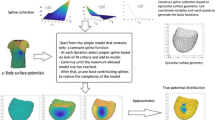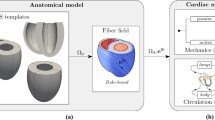Abstract
The electrocardiogram (ECG) is ubiquitously employed as a diagnostic and monitoring tool for patients experiencing cardiac distress and/or disease. It is widely known that changes in heart position resulting from, for example, posture of the patient (sitting, standing, lying) and respiration significantly affect the body-surface potentials; however, few studies have quantitatively and systematically evaluated the effects of heart displacement on the ECG. The goal of this study was to evaluate the impact of positional changes of the heart on the ECG in the specific clinical setting of myocardial ischemia. To carry out the necessary comprehensive sensitivity analysis, we applied a relatively novel and highly efficient statistical approach, the generalized polynomial chaos-stochastic collocation method, to a boundary element formulation of the electrocardiographic forward problem, and we drove these simulations with measured epicardial potentials from whole-heart experiments. Results of the analysis identified regions on the body-surface where the potentials were especially sensitive to realistic heart motion. The standard deviation (STD) of ST-segment voltage changes caused by the apex of a normal heart, swinging forward and backward or side-to-side was approximately 0.2 mV. Variations were even larger, 0.3 mV, for a heart exhibiting elevated ischemic potentials. These variations could be large enough to mask or to mimic signs of ischemia in the ECG. Our results suggest possible modifications to ECG protocols that could reduce the diagnostic error related to postural changes in patients possibly suffering from myocardial ischemia.






Similar content being viewed by others
References
Adams, M. G., and B. J. Drew. Body position effects on the ECG: implication for ischemia monitoring. J. Electrocardiol. 30:285–291, 1997.
Adams-Hamoda, M. G., M. A. Caldwell, N. A. Stotts, and B. J. Drew. Factors to consider when analyzing 12-lead electrocardiograms for evidence of acute myocardial ischemia. Am. J. Crit. Care 12(1):9–16, 2003; quiz 17–8.
Amoore, J. N., Y. Rudy, and J. Liebman. Respiration and the ECG: a study using body surface potential maps. J. Electrocardiol. 21(3):263–271, 1988.
Barnard, A. C. L., I. M. Duck, and M. S. Lynn. The application of electromagnetic theory to electrocardiology: I. Derivation of the integral equations. Biophys. J. 7:433–462, 1967.
Barr, R. C., M. Ramsey, and M. S. Spach. Relating epicardial to body surface potential distributions by means of transfer coefficients based on geometry measurements. IEEE Trans. Biomed. Eng. 24:1–11, 1977.
Birnbaum, S. L., Y. Hale, and R. A. Kloner. Changes in R wave amplitude: ECG differentiation between episodes of reocclusion and reperfusion associated with ST-segment elevation. J. Electrocardiol. 30:211–216, 1997.
Brenner, S., and R. L. Scott. The Mathematical Theory of Finite Element Methods (2nd ed.). New York, NY: Springer-Verlag, 2002.
Bridges, S. L., J. S. Hollowell, S. W. Stagg, K. A. Kemle, M. L. Nusynowitz, D. C. Allensworth, D. B. Pryor, and J. R. Moorman. Is silent ischemia on the routine admission ECG an important finding? J. Electrocardiol. 26(2):131–136, 1993.
Charulatha, R., and Y. Rudy. Electrocardiographic imaging: I. Effect of torso inhomgeneities on body surface electrocardiographic potentials. J. Cardiovasc. Electrophysiol. 12:229–240, 2001.
de Munck, J. C. A linear discretization of volume conductor boundary integral equation using analytically integrated elements. IEEE Trans. Biomed. Eng. 39(9):987–990, 1992.
Drew, B. J., and M. G. Adams. Clinical consequences of ST-segment changes caused by body position mimicking transient myocardial ischemia: hazards of ST-segment monitoring. J. Electrocardiol. 34(3):261–264, 2001.
Drew, B. J., and M. W. Krucoff. Multilead ST-segment monitoring in patients with acute coronary syndromes: a consensus statement for healthcare professionals. ST-segment monitoring practice guideline international working group. Am. J. Crit. Care 8(6):372–386, 1999; quiz 387–8.
Ferguson, A. S., and G. Stroink. Factors affecting the accuracy of the boundary element method in the forward problem I: calculating surface potentials. IEEE Trans. Biomed. Eng. 44(11):1139–1155, 1997.
García, J., M. Aström, J. Mendive, P. Laguna, and L. Sörnmo. ECG-based detection of body position changes in ischemia monitoring. IEEE Trans. Biomed. Eng. 50(6):677–685, 2003.
Geneser, S. E., R. S. MacLeod, and R. M. Kirby. Application of stochastic finite element methods to study the sensitivity of ECG forward modeling to organ conductivity. IEEE Trans. Biomed. Eng. 55(1):31–40, 2008.
Geneser, S. E., D. B. Xiu, R. M. Kirby, and F. B. Sachse. Stochastic Markovian modeling of electrophysiology of ion channels: reconstruction of standard deviations in macroscopic currents. J. Theor. Biol. 245(4):627–637, 2007.
Goldberger, A. L., and E. Goldberger. Clinical Electrocardiography. St. Louis: C.V. Mosby, 1986.
Grosse-Heitmeyer, W. Is there a specific response of the ECG R-wave amplitude to exercise induced myocardial ischemia? Exercise test and dipyridamole test. Schweiz. Med. Wochenschr. 123:414–421, 1993.
Gulrajani, R. M. The forward and inverse problems of electrocardiography. EMBS Mag. 17(5):84–101, 1998.
Huiskamp, G. J. M., and A. van Oosterom. The effect of torso inhomogeneities on body surface potentials. J. Electrocardiol. 22:1–20,1989.
Lexhava, M. G., N. Khvichiia, and K. V. Iosava. Assessment of the diagnostic significance of R wave amplitude changes in patients with ischemic heart disease in computer-assisted monitoring analysis of ECG during treadmill tests. Kardiologiia 30:63–65, 1990.
MacLeod, R. S., R. L. Lux, and B. Taccardi. A possible mechanism for electrocardiographically silent changes in cardiac repolarization. J. Electrocardiol. 30(Suppl.):114–121, 1997.
MacLeod, R. S., R. M. Miller, M. J. Gardner, and B. M. Horáček. Application of an electrocardiographic inverse solution to localize myocardial ischemia during percutaneous transluminal coronary angioplasty. J. Cardiovasc. Electrophysiol. 6:2–18, 1995.
MacLeod, R. S., Q. Ni, B. Punske, P. R. Ershler, B. Yilmaz, and B. Taccardi. Effects of heart position on the body-surface ECG. J. Electrocardiol. 33(Suppl.):229–238, 2000.
MacLeod, R. S., B. Taccardi, and R. L. Lux. Electrocardiographic mapping in a realistic torso tank preparation. In: Proceedings of the IEEE Engineering in Medicine and Biology Society 17th Annual International Conference. New York: IEEE Press, 1995, pp. 245–246.
Madias, J. E. Comparability of the standing and supine standard electrocardiograms and standing sitting and supine stress electrocardiograms. J. Electrocardiol. 39:142–149, 2006.
Nelwan, S. P., S. H. Meij, T.B. van Dam, and J. A. Kors. Correction of ECG variations caused by body position changes and electrode placement during ST-T monitoring. J. Electrocardiol. 34:213–216, 2001.
Oostendorp, T. F., A. van Oosterom, and G. J. Huiskamp. Interpolation on a triangulated 3D surface. J. Comput. Phys. 80:331–343, 1989.
Seigneur, S., T. W. Teche, R. M. Roth, and L. E. Reid. Sensitivity of complex urban air quality model to input data. J. Appl. Meteorol. 20:157–177, 1981.
Shusterman, V., A. Goldberg, D. M. Schindler, K. E. Fleishcmann, R. L. Lux, and B. J. Drew. Dynamic tracking of ischemia in the surface electrocardiogram. J. Electrocardiol. 40:S179–S186, 2007.
Smolyak, S. Quadrature and interpolation formulas for tensor products of certain classes of functions. Soviet Math. Dokl. 4:240–243, 1963.
Stinstra, J. G. The Reliability of the Fetal Magnetocardiogram. PhD thesis, Universiteit Twente, Enschede, Netherlands, 2001.
Xiu, D. Efficient collocational approach for parametric uncertainty analysis. Commun. Comput. Phys. 2(2):293–309, 2007.
Xiu, D. B. Fast numerical methods for robust optimal design. Eng. Opt. 40(6):489–504, 2008.
Xiu, D. B., and J. S. Hesthaven. High-order collocation methods for differential equations with random inputs. SIAM J. Sci. Comput. 27(3):1118–1139, 2005.
Xiu, D. B., and J. Shen. An efficient spectral method for acoustic scattering from rough surfaces. Commun. Comput. 2(1):54–72, 2007.
Acknowledgments
The authors would like to thank Dr. Dongbin Xiu of Purdue University (USA) for his generous help with generalized polynomial chaos and Dr. Tom Fletcher for his mathematical insights. We also appreciate the input on clinical electrocardiography from Ravi Ranjan, MD/PhD and Chris McGann, MD. We also gratefully acknowledge the computational support and resources provided by the Scientific Computing and Imaging Institute. This work was funded by a University of Utah Seed Grant Award, NSF Career Award (Kirby) NSF-CCF0347791, NSF IIS-0914564, and the NIH NCRR Center for Integrative Biomedical Computing (http://www.sci.utah.edu/cibc), NIH NCRR Grant No. P41-RR12553-12. Support for the acquisition of the experiment data came from the Nora Eccles Treadwell Foundation.
Author information
Authors and Affiliations
Corresponding authors
Additional information
Associate Editor Joan Greve oversaw the review of this article.
Rights and permissions
About this article
Cite this article
Swenson, D.J., Geneser, S.E., Stinstra, J.G. et al. Cardiac Position Sensitivity Study in the Electrocardiographic Forward Problem Using Stochastic Collocation and Boundary Element Methods. Ann Biomed Eng 39, 2900–2910 (2011). https://doi.org/10.1007/s10439-011-0391-5
Received:
Accepted:
Published:
Issue Date:
DOI: https://doi.org/10.1007/s10439-011-0391-5




